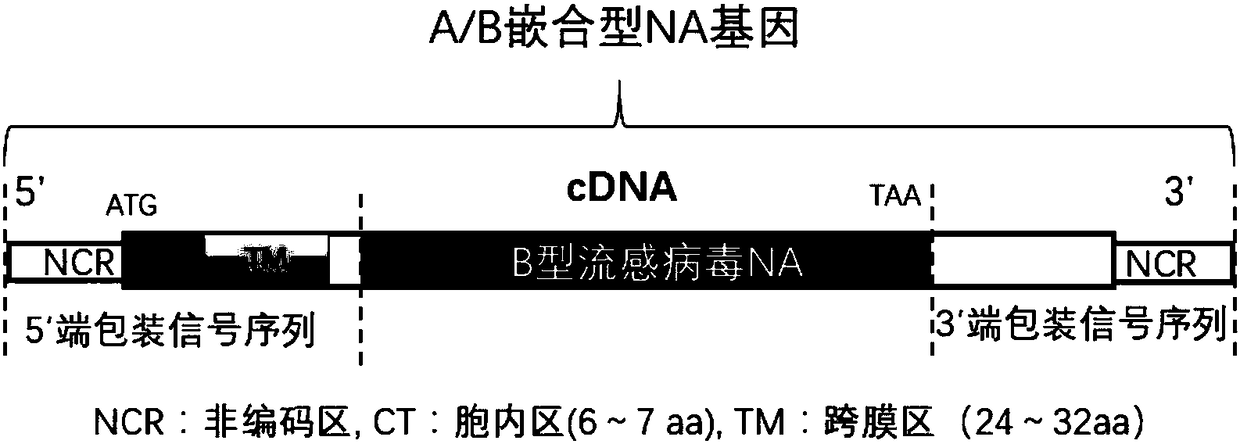H5 subtype avian influenza vaccine strain capable of distinguishing immunized and infected animals, and preparation method and application thereof
A technology for avian influenza and vaccine strains, which is applied in the field of preparing vaccine strains for distinguishing immunity and infection of H5 subtype avian influenza, can solve the problems of inability to completely eliminate highly pathogenic avian influenza, antigenic drift, and antigenicity differences of vaccine strains, and achieve Highlight the significance of public health safety, avoid antigenic variation, good replication and growth effects
- Summary
- Abstract
- Description
- Claims
- Application Information
AI Technical Summary
Problems solved by technology
Method used
Image
Examples
Embodiment 1
[0043] The preparation method of embodiment 1 avian influenza vaccine strain Re-MuH5-DIVA-ΔNS virus
[0044] (1) Construction of low pathogenicity HA mutant gene
[0045] The pFlu vector is a bidirectional transcription vector, which can not only transcribe the RNA of the complete virus at the human polI promoter, but also transcribe the viral mRNA under the CMV promoter, thereby synthesizing the viral protein (Hoffmann et al., PNAS, USA 97,6108- 6113, 2000).
[0046] Artificially synthesized wild-type H5 gene (A / Duck / Hubei / 49 / 2005), the highly conserved sequence (RERRRKRGLF) in the highly pathogenic wild-type HA amino acid sequence was mutated into a low-pathogenic amino acid sequence by site-directed mutagenesis (RETRGLF) to obtain the corresponding low pathogenicity MuH5HA gene sequence. Cloning the modified MuH5HA gene into the pFlu vector through the BsmBI site to obtain the recombinant plasmid pFlu-MuH5HA, the construction principle is as follows figure 2 shown.
[...
Embodiment 2
[0054] The preparation method of embodiment 2 avian influenza vaccine strain Re-MuH5-DIVA-ΔNS virus
[0055] The preparation method in this embodiment 2 is the same as that of embodiment 1, except that figure 1When the A / B chimeric NA gene is artificially synthesized, the DNA sequence encoding the amino acid sequence of the extracellular domain protein in the influenza B virus NA is different from that in Example 1, and the others are the same as in Example 1.
[0056] In this embodiment, the DNA sequence encoding the amino acid sequence of the extracellular domain protein (SEQ ID NO: 6) in influenza B virus NA is shown in SEQ ID NO: 7, as the tag gene sequence, shown in SEQ ID NO: 7 The sequence of B is from B / Brisbane / 60 / 2008 in the Victoria group of influenza virus B (Ping J et al, PNAS, 2016, 113(51):E8296-E8305).
[0057] Next, the Re-MuH5-DIVA-ΔNS vaccine strain prepared by the present invention is further tested for its effect.
[0058] Method: the Re-MuH5-DIVA-ΔNS va...
Embodiment 3
[0064] Embodiment 3 Preparation of Re-MuH5-DIVA-ΔNS inactivated vaccine
[0065] Collect 50 ml of the allantoic fluid of Re-MuH5-DIVA-ΔNS vaccine strain F0, F1, F2 or F3 prepared in the above example, and inactivate it with formalin solution with a final concentration of 0.25% at 37°C for 24 hours. Add 2% Tween-80 to the inactivated allantoic fluid, emulsify with white oil containing 3% Span 80 after fully dissolving, the emulsification ratio is 1:3, the shear emulsification speed is 12000rpm, 3min. Through dosage form inspection, particle size inspection, viscosity inspection, and stability inspection, it is determined that the inactivated oil seedlings are milky white water-in-oil emulsion with low viscosity, uniform particle size, good stability, and suitable for injection.
PUM
 Login to View More
Login to View More Abstract
Description
Claims
Application Information
 Login to View More
Login to View More - Generate Ideas
- Intellectual Property
- Life Sciences
- Materials
- Tech Scout
- Unparalleled Data Quality
- Higher Quality Content
- 60% Fewer Hallucinations
Browse by: Latest US Patents, China's latest patents, Technical Efficacy Thesaurus, Application Domain, Technology Topic, Popular Technical Reports.
© 2025 PatSnap. All rights reserved.Legal|Privacy policy|Modern Slavery Act Transparency Statement|Sitemap|About US| Contact US: help@patsnap.com



